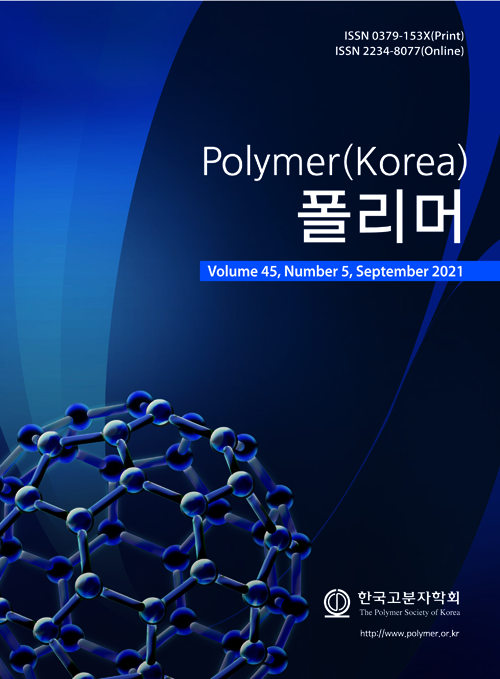- Heat Radiating Material with Paraffin Microencapsule and Alumina
Department of Polymer Science and Engineering, Pusan National University, 2, Busandaehak-ro 63beon-gil, Geumjeong-gu, Busan 46241, Korea
- 파라핀 마이크로인캡슐과 알루미나로 이루어진 방열 소재
부산대학교 고분자공학과
Reproduction, stored in a retrieval system, or transmitted in any form of any part of this publication is permitted only by written permission from the Polymer Society of Korea.
As electronic devices become highly integrated, more heat is generated, and this heat not only degrades the function of the device, but also causes malfunction of peripheral devices, so much interest and research are being made on technology for controlling heat. Heat radiating materials are mainly manufactured in a composite form by adding a thermally conductive filler to a polymer. And in order to achieve high thermal conductivity, the amount of filler must be increased, which makes processing difficult and the mechanical properties of the composite material deteriorate. In this study, a new filler encapsulating paraffin is introduced to increase the heat dissipation effect of the heat radiating material. Paraffin undergoes a phase change to a liquid due to heat, and a liquid leak of paraffin occurs in the heat dissipating material, acting as a defect. Accordingly, the leakage problem was solved by encapsulating paraffin using polyurethane as a wall material. Paraffin microencapsules were not homogeneous, but formed particles with a diameter of about 100 µm. In addition, as a result of measuring the thermal conductivity of the prepared epoxy/(paraffin microencapsule+alumina) heat radiating material, it was confirmed that thermal conductivity gradually decreased due to the introduction of paraffin microencapsules, resulting in continuous heat dissipation.
전자 소자가 고집적화될수록 더욱 많은 열이 발생하는데, 이러한 열은 소자의 기능을 떨어뜨릴 뿐만 아니라 주변 소자의 오작동 원인이 되고 있어 열을 제어하는 기술에 대해 많은 관심과 연구가 이루어지고 있다. 방열 소재는 주로 고분자에 열전도성 필러를 첨가한 복합체 형태로 제작되고 있다. 높은 열전도도를 달성하기 위해서는 필러의 양을 늘릴 수밖에 없으며, 이로 인해 가공이 어려워지고 복합재료의 기계적 물성도 나빠진다. 본 연구에서는 알루미나와 에폭시로 이루어진 방열 소재에 높은 잠열을 가진 파라핀을 캡슐화한 새로운 필러를 도입하여 방열 효과를 높인다. 파라핀은 열에 의해 액체로 상변화가 일어나며, 방열 소재 내에서 파라핀의 누액이 발생하여 결함으로 작용하게 된다. 이에 폴리우레탄을 벽재 물질로 사용하여 파라핀을 캡슐화하여 누액 문제를 해결하였다. 파라핀 마이크로인캡슐은 균일하지는 않지만 지름이 약 100 μm인 입자를 형성하였다. 또한 제작한 에폭시/(파라핀 마이크로인캡슐+알루미나) 방열 소재의 열전도도를 측정한 결과, 파라핀 마이크로인캡슐의 도입으로 열전도도의 감소가 서서히 일어나 지속적으로 방열이 일어남을 확인하였다.
Keywords: heat radiating material, polymer composite, paraffin microencapsule, alumina, phase change material.
- Polymer(Korea) 폴리머
- Frequency : Bimonthly(odd)
ISSN 0379-153X(Print)
ISSN 2234-8077(Online)
Abbr. Polym. Korea - 2023 Impact Factor : 0.4
- Indexed in SCIE
 This Article
This Article
-
2021; 45(5): 673-679
Published online Sep 25, 2021
- 10.7317/pk.2021.45.5.673
- Received on Mar 3, 2021
- Revised on May 4, 2021
- Accepted on May 11, 2021
 Correspondence to
Correspondence to
- Nam-Ju Jo
-
Department of Polymer Science and Engineering, Pusan National University, 2, Busandaehak-ro 63beon-gil, Geumjeong-gu, Busan 46241, Korea
- E-mail: namjujo@pusan.ac.kr










 Copyright(c) The Polymer Society of Korea. All right reserved.
Copyright(c) The Polymer Society of Korea. All right reserved.